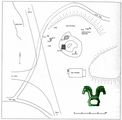Pillerhöhe
| Field name | |
|---|---|
| Site: | Fliess [from first object] |
| Coordinates: | 47° 7' 8.40" N, 10° 40' 1.20" E [from first object] |
| Objects found here: |
|
Map
Commentary
The Pillerhöhe is the transition point between the Upper Inn valley near Prutz and Fliess and the Pitz valley, which forms a more direct connection to Imst in the Inn valley that the course of the Inn via Landeck; this old road is known as Alter Weg (see image below). The archaeological site is situated on an area of even ground inside a bend in that road on the crest, at an altitude of 1560 m a.s.l., close to a high, steep drop which is clearly visible from afar (Tschurtschenthaler & Wein 2002: 637–639).
On 6 May 1992, the laymen Kassian Erhart and Franz Neururer reported the discovery of about 70 objects on the Pillerhöhe to the Institute of Classical Archaeology of the University of Innsbruck. After a survey, excavations were started immediately. In the following years, annual excavations were undertaken by the University of Innsbruck (Tschurtschenthaler & Wein 2002: 636f.).
|
site plan of the sanctuary on the Pillerhöhe
|
The site can be identified as a sanctuary which was in use from the Middle Bronze Age to Late Antiquity. In the earliest period, the offerings were primarily parts of animals and other foodstuffs, which were burned at the altar and deposited on a bone-and-ash heap. Around the turn from the Hallstatt to the La Tène period, object sacrifices begin to appear, and become dominant or exclusive in the 4th/3rd–1st centuries BC. From the 1st century BC onwards, offerings in monetary form (Roman and Celtic coins) are made as well. See Tschurtschenthaler & Wein 1998: 234–240 and Tschurtschenthaler & Wein 2002: 639–652 for details about the excavations, structures and find phases.
The object sacrifices of the Late Iron Age comprise items from all areas of daily life: ornaments and other attire, weapons, various implements and tools, and pottery. Moreover, there are objects which were produced exclusively for the sacrifice, such as the anthropomorphic bronze plaques and symbolic pars pro toto weapon sacrifices in form of bronze plaques which imitate shields (cf. IT-9 fragment). See Tschurtschenthaler & Wein 1998: 240–247 and Tschurtschenthaler & Wein 2002: 652–664 for details about the find types, and images. Judging by the types of finds, the sanctuary was used by men as well as by women (Tschurtschenthaler & Wein 2002: 652). The objects were not burned, but ritually destroyed. They were found distributed all over the more norherly area of the sanctuary, called the fairground (Festwiese), though many appear to have ended up there secondarily (Tschurtschenthaler & Wein 1998: 236f.). The fairground features stone piles (SA1, SA2) – possibly the remains of structures to which votives were attached (Tschurtschenthaler & Wein 1998: 237) – and fireplaces (F1–8) as shown in the image above; it is thus called under the assumption that it was the place where the participants of the offering stood (Tschurtschenthaler & Wein 1998: 231).
Inscribed objects from the Pillehöhe are, so far, the handle of a Henkelbecher IT-8 potsherd and the fragment of a miniature shield IT-9 fragment, beside two bowls with script-like marks (EX-114, EX-115; see Non-script notational systems).
See Tschurtschenthaler & Wein 1998: 227f. with a map Abb.1 and 249–253 for considerations concerning the relation of the site to the old road and to the Via Claudia, which passed Fliess on its way from the Reschen pass to Landeck.
Find spots from the environs of the Pillerhöhe which have not yielded any inscribed objects include the hoard from Fliess which dates to the Hallstatt period (cf. the marks on bronze axes kept at Archäologisches Museum Fliess mentioned here; see also Sydow 1995), the weapon deposits from the Piller and from Wenns, as well as the remains of a prehistoric settlement somewhat to the south of the sanctuary site. All these find spots are located near and must be associated with the Alter Weg from Fliess to Imst (Tschurtschenthaler & Wein 2002: 639 with literature n. 8 and 17).
